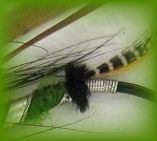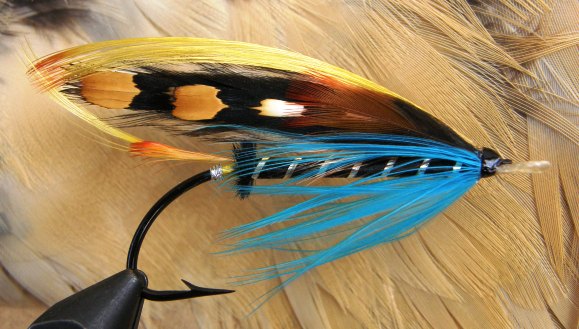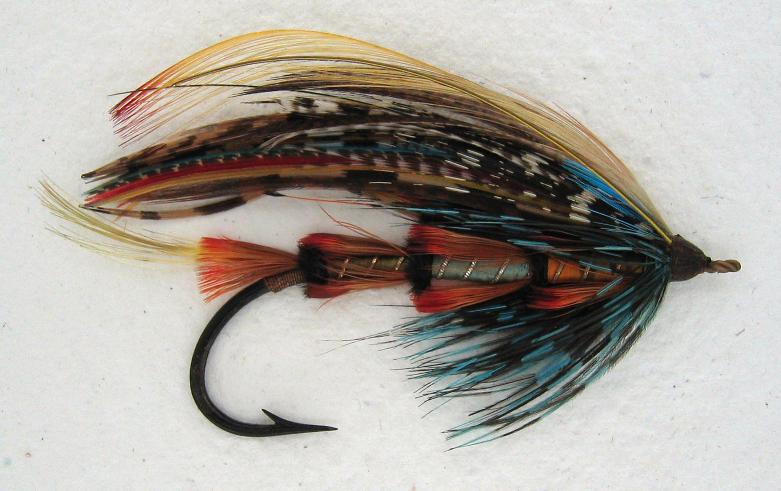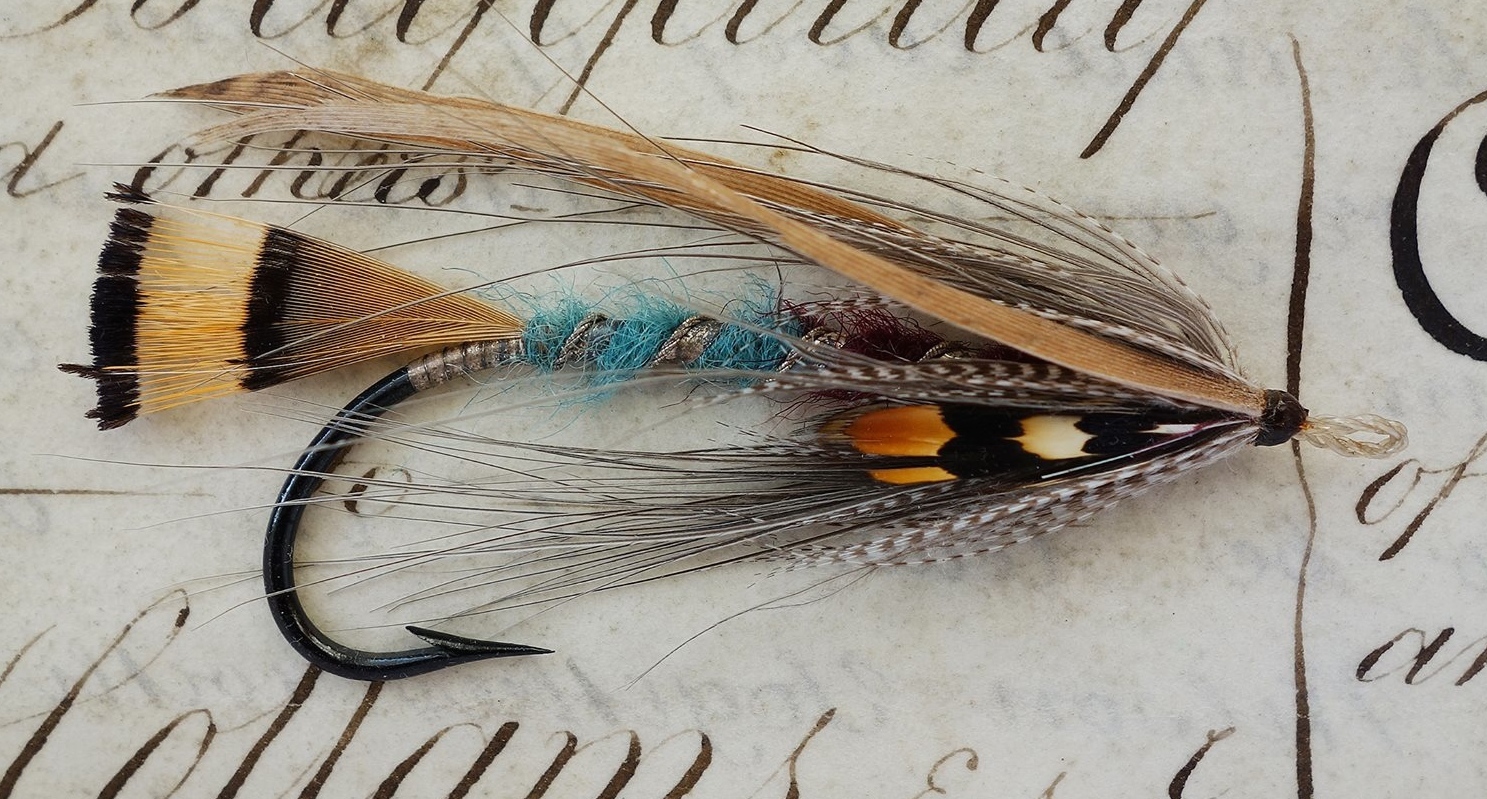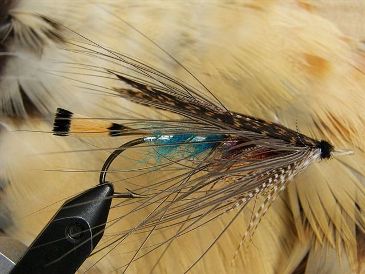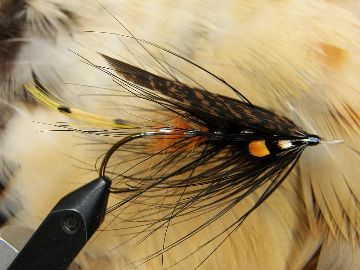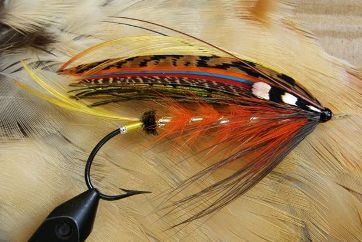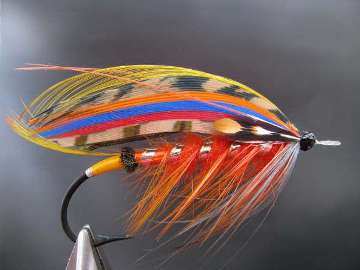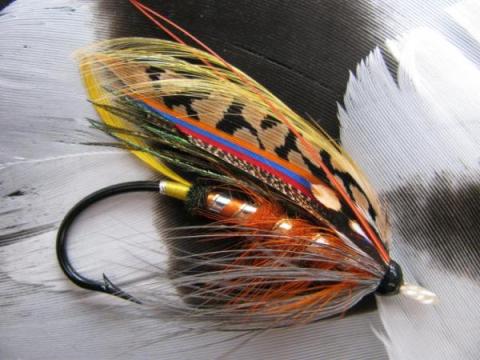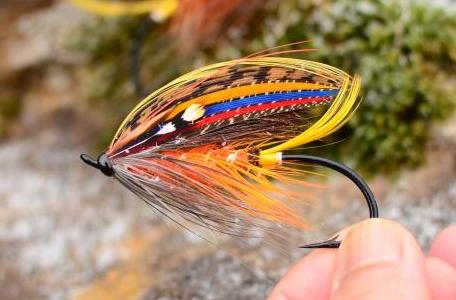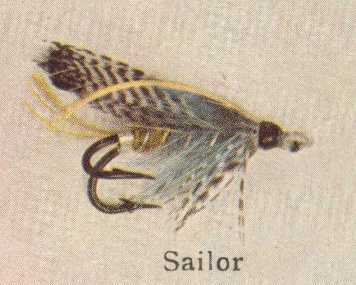 |
 |
|
On this page, Pitfour, Playfairs Favourite, Popham, Red Doctor, Red Drake, Red Wing, Rintoul, Robbie, Sailor. Please scroll down to see 'em. Pitfour WM Tag: Silver twist, and one turn yellow floss. Tail: Small topping, and Indian crow. Butt: Black herl Body: Black silk floss, neatly and sparely laid on. Ribbed: Silver tinsel, very narrow, 7 turns. Wings: Double jungle, supporting a couple of toppings. Sides: A sprig of Indian crow (short), from out each side of body, half way between head and butt. Hackle: Sparse, greenish-blue hackle, simply round shoulder, and extending in length almost to tag. Head: Black Brazed irons – Nos. 5, 6, 7, to suit the size of the water. A very good killer – grilse or salmon; [on the Dee] suits best a fairly large water of brownish shade, occasioned by the west winds causing extra outflow from the lochs, or a few days’ rain on the hills and moors giving the water a peaty tinge. In appearance, especially in the water, this fly has a close resemblance to the Jock Scott. For summer fishing, under conditions such as described, it can be used with greater advantage from morning till about five or six in the evening than later on. WM describes this fly as “one of our own patterns”.
Popham
A very expensive (due to Indian Crow) general fly - couldn't resist a big picture of this classic vintage fly Kelson – Land & Water Cards The Popham comes under the class know to salmon anglers as a slight exaggeration. It invariably over dressed, and then the fisherman is more likely to fail owing to difficulty experienced with presentation. This over dressing is generally noticeable in the body, the Indian crow feathers being used being too large. Lightly handled, the fly fishes itself, it requires no effort. My own experience with the Popham, with all its peculiar distinctions, goes to show that it kills best when the Indian crow’s feathers are scarcely more than half the length of those given in the illustration. This is dressed as follows: Tag: Gold twist. Tail: A topping and Indian crow. Butt: Black herl. Body: In three equal sections, butted with black herl. The first dark orange silk, ribbed with fine gold tinsel, having Indian crow above and below; the second, or middle joint, of yellow silk with the ribbing and crow’s feathers repeated; the third of light blue silk, but with silver ribbing and the crow’s feathers, as before. Hackle: Jay at the throat only. Wings: Tippet, teal, gallina, golden pheasant tail, parrot, light brown mottled turkey, bustard, ref macaw, yellow macaw, (swan dyed yellow for large sizes), with two strips of mallard above and a topping. Horns: Blue macaw. Cheeks: Chatterer. Head: Black herl.
Red Drake Kelson – The Salmon Fly, 1885 Tag: Gold twist and light blue silk. Tail: Toucan, ibis, and Butt: Black herl. Body: One third of buttercup silk and black silk, having a red-orange hackle down it. Throat: Jay. Ribs: Gold tinsel (oval). Wings: Two spreading strips of Mandarin Drake, white tipped (a fair imitation is occasionally found on the domestic mallard) and a topping. Horns: Blue macaw. Head: Black herl. Used on the Earn, Aberdeenshire Dee, Teviot, Blackwater (Mallow district), Usk and Wye. Kelson attributes the pattern to himself Hardy – Salmon Fishing, 1907 Tag: Gold tinsel; light blue floss. Tail: Toucan; ibis; Butt: Black herl. Body: One third buttercup floss and black floss with a red orange hackle over. Ribs: Gold tinsel. Throat: Jay. Wings: Two spreading strips of mandarin drake, white tipped; topping. Horns: Blue macaw. Head: Black.
Red Wing, or Red-Winged Heron
A Vintage one from Long Nguyen's collection - Murdoch's dressing 14th March 1885
Tied by Bob Frandsen - Murdoch's dressing 3rd March 1888 This is one of a family of similar flies that includes the Gled Wing and the Glen Tannar WM Tag: Silver tinsel. Tail: Fibres of golden pheasant tippet. Body: Blue and claret mohair. Rib: Silver tinsel. Hackle: Grey heron well through the body. Shoulder: Teal. Wing: Very dark turkey, the deeper the brown the better. Head: Black. WM – Tag: Narrow silver tinsel. Tail: Fibres of tippet Body: Light blue and rich claret coloured mohair, equal parts, and picked out a little – the claret-coloured mohair most. Ribbed: Broad flat silver tinsel and silver twist, five turns Hackle: About 20 long fibres grey heron at shoulder only Shoulder: Teal sparsely, round about. Wings: Particularly dark- brown turkey strips Cheeks: Jungle Head: Black Mr. George Smith, Tackle Merchant, Ballater, has a splendid stock of these patterns, most of which are proved killer on all reaches above, and a good many reached below, that place. William Murdoch - Tag: Narrow silver tinsel. Tail: Two sprigs tippet, back to back, and upright. Body: Seal’s fur, or mohair, fairly picked out; first half light blue, second half claret. Ribbed: Broad flat silver tinsel, edged with gold twist (treble). Hackle: Grey heron of longest fibre run down from first turn tinsel to the head; teal at shoulder. Wing: Two strips of the darkest brown turkey feather procurable, each extending flatwise outward at an angle of 25 - 30 degrees. (see illustration). Head: Black wool.
The Red Wing fly is one of a few patterns used on Dee, Don, Deveron, Ythan, and several other northern rivers, that while possessing old and familiar names telling of well-authenticated stunning records of genuine sport, had gradually fallen into disuse as the years rolled on and new “blood” came on the scene, until only a few years ago they had almost wholly died out among the then anglers, when, as if all of a sudden, by several of the most successful and intelligent rods, desirous to try the cherished patterns of their fathers in the art, they were revived, and with some alterations (which are considered improvements) were brought out under the old names, and their bringing, as it has done, such immense success to those using them has made their re-introduction as popular, as popular and good friends all were the worthy old hands who first used them. The Red Wing is the invention of dear “Old Dusty,” now, alas, no more; a keen and true angler in every sense. eager ever for sport himself and as eagerly bent and solicitous for others having it, and than whom no more genial companion, friend, and guide, versed in flies, fishing, fish lore, and fishes’ ways, one could have had or wished at the river side. These lines are penned not without feeling, and are a brief and feeble but well-merited tribute to the memory of one of a class of fishermen that is fast passing away. The Red Wing is not a summer fly, but either in spring or autumn it does admirably, used in from low to fairly high water, the size of course (of the fly) being suitable, and chiefly on darkish days is it most telling. Mr. Jopp, the well known angler, pays it a high tribute in saying that on the Deveron “it takes fish both inside and outside the mouth!” and that for that river “he places it in front of any other fly.” On many occasions the writer has had great sport with it on the Aberdeenshire Dee, and it is the companion fly of the “Dr. Forbes,” invented by Dr. Forbes, of
Rintoul
Tied by Bob Fransden WM Tag: Silver tinsel. Tail: A topping and fibres of golden pheasant tippet. Body: Two turns orange and three turns black mohair. Rib: Silver tinsel and gold twist. Hackle: Black heron down the body. Cheeks: Jungle cock. Wing: Sand coloured turkey. Head: Black On The dressing of the “Rintoul,” previously described, may, if desired, be supplemented by a little golden pheasant rump around the shoulder. We, however, prefer this fly, minus the addition indicated.
Red Doctor Tied by Dave Carne Robbie
WM Tag: Silver thread with yellow floss. Tail: Two golden pheasant toppings. Butt: Bronze peacock herl Body: One turn light orange floss, remainder dark orange mohair. Ribbing: Silver tinsel and gold twist. Hackle: Dark orange hackle from first turn; long grey heron at shoulder. Wings, Fibres of bronze peacock herls, bustard, red, blue and orange swan, and golden pheasant tail, topping over all. Cheek: jungle feather on each. Horns: red and blue macaw. Head: Black. The “Robbie,” a very excellent spring fly (fancy), may be said to have died out with its inventor, Mr George Robbie, late land steward, Blackhall, than whom none could dress a Dee fly with greater exactness and finish. A pupil of Robbie’s himself, a very good fly-dresser, has kindly supplied us with a pattern of this hook, which we will afterward describe for the benefit of those who may wish to give the “Robbie” a trial. It is a fly well worth experimenting with, if appearance goes for anything. Some further information on Robbie can be found in a "Famous Fishermen" article in the Fishing Gazette, this one is about Frank Farquharson, the head fisherman at "Frank is a reader, a scholar of no mean order, and a capital penman. As a tier of flies he has few equals and no superiors on Deeside. He learned the secrets of his art from George Robbie, a famous angling worthy, who’s wonderful fishing achievements were know to all frequenters of the Aberdeenshire Dee, when the present century was but half run. George was for many years the land steward at Blackhall, and as long as he was able he never lost a convenient opportunity for making a “saumon’s tail toddle.” After living his time he quietly departed, leaving behind him the reputation for being the best fly dresser of his day and generation. His mantle fell on Frank; and Frank’s flies are so much in request, that he might easily make a fortune if he would devote himself to the business of tackle making."
Sailor William Murdoch - ??????? _ Fishing Gazette Tag: Silver twist. Tail: A topping Body: Equal sections of bright yellow and light blue fur. Ribbed: Oval silver tinsel. Hackle: Greenish blue over the light blue fur. Wing: Double strips of finely marked teal, on either side; topping over. Cheeks: Chatterer. Head: Black wool. In so far as harmonious blending of colours is concerned, the Sailor is inferior to no fly ever invented. A tempting and smart looking fly, it has a very pretty appearance in the water. For a change from the ordinary run of flies, a better could not be desired. On the Kelson – The Salmon Fly, 1885 Tag: Silver twist. Tail: A topping. Body: Yellow seal’s fur and blue seal’s fur, equally divided. Ribs: Silver tinsel (oval). Hackle: Blue, from yellow fur. Wings: Two strips of teal and a topping. Cheeks: Chatterer. Head: Blue wool. An excellent fly on the Kelson attributes the pattern to William Brown. Hardy – Salmon Fishing, 1907 Tag: Silver tinsel. Tail: Topping. Body: Yellow seal’s fur and blue seal’s fur in equal parts. Ribs: Silver tinsel. Hackle: Blue. Wings: Two strips of teal; topping. Cheeks: Chatterer. Head: Blue wool. “Jock Scott” – Greased Line Fishing for Salmon, 1936 Tag: Silver wire Tail: G.P. crest. Body: In two halves of yellow and blue seal’s fur. Wings: Pintail strips and crest over. Cheeks: Blue kingfisher. Saturday This is the original pattern for the Saturday from William Garden (differs from other published versions) Tag: Silver Oval and Yellow floss silk Tail: GP Topping and Indian Crow Butt: Black wool Body: Black Wool or black floss Ribs: Flat Silver Throat: Light blue cock Wings: Two strips of cream coloured turkey, cheeks of Indian crow and 3 GP toppings over all
|
